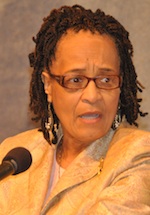Racism in the North Hurt me as Much as Racism in the South
Barbara Reynolds
Trice Edney News Wire
On March 7, 1965, before my grandmother could quickly change the channel from the evening news, I caught a glimpse of White men on horseback in Selma, Ala., beating people who looked like me. Astonished, I turned to my grandmother: “Why?” She shrugged and changed the subject.
As a Black student from Ohio, I had never seen brutal racism or thought much about skin color. My relatives and teachers protected me from the painful realities of racial hatred. It wasn’t uncommon for adults to keep secret the stories of our agonizing past — slavery, Jim Crow, legal injustice and Southern terror — fearing it would make children feel either inferior or rebellious enough to stir up unnecessary trouble. My parents voted and owned property; my history books presented sanitized versions of history; and the police officer who visited my school was always friendly. The sheltering was an effort to put the past behind us. Even amid the horrifying images from Edmund Pettus Bridge, the adults around me wouldn’t provide answers. In frustration, I decided to head south to find out for myself.
I joined an integrated group of students from Ohio State University, where I was a freshman, going south to meet Dr. Martin Luther King. Jr., who was leading the drive for voting rights. I thrust myself into the world of Jim Crow, naïve to the murderous vigilantism that enforced the rules of segregation. But white Southerners weren’t the only ones who would shatter my wall of innocence. Black Southerners distanced themselves from our cause, uninterested in stirring a pot that they knew could easily boil over with racial violence. And one of the biggest shocks came after I returned to Ohio. As I headed south with my friends in a pea-green jalopy, I did not know that, upon returning home, the emotional pain of Northern racism would wound as deeply as the threats of physical harm in the South.
Most of the students in our group had never ventured far from Ohio, so we proudly told our friends that we were going south to be with Dr. King, as though when we crossed the Mason-Dixon line he would be standing there with out-stretched arms. Instead of heading for Selma, however, our team leaders answered an invitation to aid a church group who needed volunteers for a May voter registration drive in Brownsville, Tenn.
We arrived on a Saturday, just before sundown. The Black churchgoers who hosted us sternly warned not to venture out after dark. But we had a better idea. On the way, we had seen a flashing neon light advertising a local bar. As soon as our hosts had gone to bed, we sneaked out to drink beer and pass the night dancing the Funky Chicken. We walked into the bar laughing and joking: three guys – one Black, one White, and one Hispanic – two blond White girls, and me. We headed to the jukebox in the corner, but just as a nickel was inserted to get things rolling, a white man with a strange drawl snatched the plug out of the wall. “Get them nig








